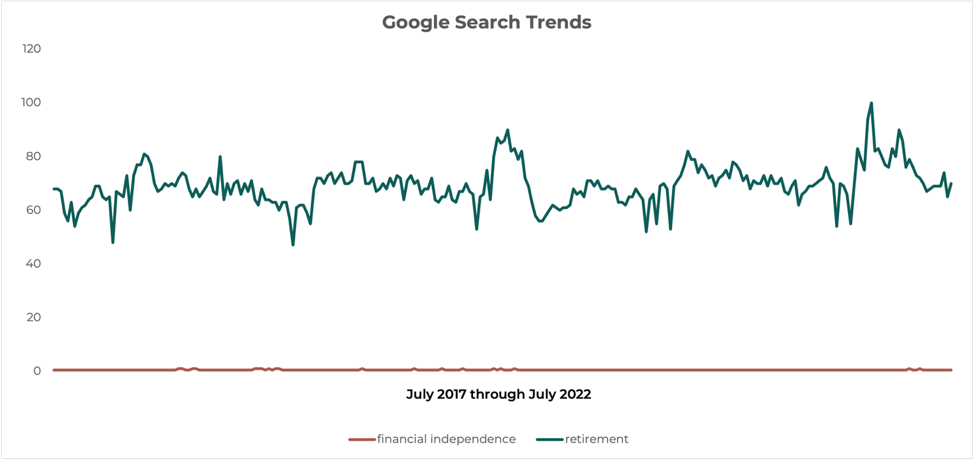I was recently speaking to top advisor Zachary Ashburn about improving brand awareness with his niche audience. Specifically, he wants to help established executives who leave their corporate jobs but aren’t ready to retire. He can help them set up a consulting business, work with a CPA, and bridge the gap to retirement on their terms.
There’s only one problem. None of that was apparent from his website. He was saying all the right things about quitting and setting up an interim business, but he was using words like “side hustle” or “day job.” While those words are technically accurate, they’re more commonly used by 20- and 30-somethings than established executives.
Shifting the wording slightly made a big difference. Now, his tagline is simpler: Your career doesn’t have to end when you leave your job. And once we nailed that tagline, ideas for how he could build out that niche started to flow. (Two prospects reached out to Ashburn in the week since he updated his language; both are more aligned with his niche.)
Changing your phrasing may help you win clients.
You may be making a similar mistake with your messaging. Consider the phrase “financial independence.” We love that term in the industry because it feels like a more holistic reflection of the work advisors do than retirement planning.
There’s only one problem: In the real world, very few people use the term “financial independence.” It barely registers against retirement in Google search data.

That means if your website is all about financial independence, prospects may have no clue what you’re talking about. Worse still, someone searching for an advisor could miss your site entirely.
Let me be clear about one thing: I’m not suggesting you ditch terms like financial independence, especially if they’re core to how you do business. What I am suggesting is that you define these terms using familiar words. You don’t want to miss an opportunity to work with someone because your message gets lost in translation.
Learn Your Clients’ Lingo. (It’s Easier Said Than Done.)
You know your clients better than most service providers. But you’re probably paying more attention to what your clients are saying than how they are saying it. At a certain point, our brains start to zoom past word choice to get to the core meaning; listening for vocabulary is a different, much more active, skillset.
It's also not easy. I’ve been working with words my entire 13-plus-year career, much of it developing messaging where word choice is critical. And with my own firm, it took me two years to realize that the words marketers loved were falling flat with advisors. (Template: bad association. Draft copy: better association.)
The good news is, you don’t have to become an expert at active listening right away, because I’m going to give you a short cut: Ask your clients.
Tap Into Your Best Resource: Survey Your Clients.
Client surveys are one of the most underused tools. And for advisors, client surveys offer a high return on investment.
- People feel important when you ask for their opinion. This is especially true if you tee things up the right way. Consider something like: “You are one of my favorite clients, so I want to find more clients like you. Can you help me do that by answering a quick survey?”
- It’s an easy way to gather useful data. You can ask about word choice and messaging, but you can also ask about overall client satisfaction. This can help you prioritize your time and grow your business more strategically.
- Who doesn’t love quantitative data? These surveys can help you quantify the intangibles—those things that you know instinctively from working with your clients but may have a hard time putting into words.
- Lay the groundwork for testimonials. You should absolutely talk to your compliance team or a compliance consultant before embarking on anything involving testimonials, but if you plan to introduce reviews or case studies in the future, this exercise can help. It gives you a preview of what people may say and helps you identify which clients you may want to feature.
- Say the right thing in a bear market. Surveys can and should go beyond evergreen questions. You should also ask about current events to quantify what clients care about in their words. Do they talk about purchasing power or do they just complain about things getting more expensive?
How to Create an Effective Client Survey:
Here are my favorite tips on creating an engaging and useful client survey from market research consultant Margaret Hoffecker:
- Start with easy, broad questions. Think yes/no answers. When surveys start off with fill in the blank or freeform answers, it sends a subconscious signal that this survey is going to take effort, and that can be just enough to make your client give up. Starting with easy questions can also help your clients ease into a groove. Try to include your “must answer” questions near the top, too, in case clients don’t finish.
- Multiple choice can help you gather useful data. There are going to be some questions where you want clients to fill in information, but in general, providing prompts can help you gather more actionable data, as you’ll be able to notice themes and spot trends that can get lost with free-form answers. You’ll also learn a lot if the prompts you offer aren’t aligned with your clients’ responses. (If you ask, “What do you find most valuable about working with us?” and your clients put “other”—that’s something to pay attention to.)
- Add freeform questions. Give people an opportunity to explain their answer as a follow-up to multiple choice questions. You can learn a lot of useful, qualitative information this way. Plus, having variety in your question formats keeps respondents actively engaged.
- Give clients the option to remain anonymous. Ask your clients for their name at the end of the survey and provide context for why (e.g., so we can follow up with you about ways to improve, or possibly feature your feedback on our site); chances are they will say yes.
Use Surveys to Improve Your Tagline.
Finally, I want to make it easy for you to create a survey about messaging. So, let’s circle back to the advisor I mentioned at the start of this article. He might ask clients:
- Which of these words or phrases do you use the most when talking about your work?
- Career
- Job
- 9-5
- Work
- What did you Google when you were thinking about quitting your job?
- How to quit a job successfully
- Can I retire early
- Setting up a consulting business
- Should I quit my job
- Other ______________________________________________
How exactly things get formatted is going to depend on which software you use, and there is a lot of software to choose from. Many platforms offer basic survey templates for free, and only begin to charge you if you create a more complicated if/then structure for your quizzes. At this stage, you probably don’t need to be that fancy unless you want to.
Finally, don’t make surveys a one-time thing. Split your clients in half and survey half in the summer and half in the winter; that way you aren’t bombarding any group, but you’re keeping your finger on the pulse of what your clients are thinking in an easy, scalable way. Plus, the qualitative answers can help you shift how you engage with clients and prospects, which may help you attract new business more organically.
Shawna Ohm is the founder of Content 151.





